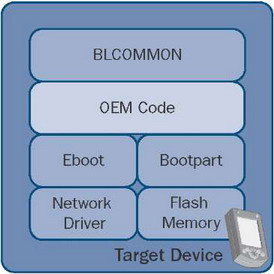Книга: Microsoft Windows Embedded CE 6.0 Exam Preparation Kit
CE Boot Loader Architecture
CE Boot Loader Architecture
The underlying idea of a boot loader is to bootstrap a small program with pre-boot routines in linear, nonvolatile, CPU-accessible memory. Having placed the initial boot loader image on the target device at the memory address where the CPU begins to retrieve code through a built-in monitor program provided by the board manufacturer or a JTAG probe, the boot loader runs whenever you power up or reset the system. Typical boot loader tasks performed at this stage include initializing the Central Processing Unit (CPU), the memory controller, system clock, Universal Asynchronous Receiver/Transmitters (UARTs), Ethernet controllers, and possibly other hardware devices, downloading the run-time image and copying it into RAM according to the binary image builder (BIB) layout, and jumping to the StartUp function. The last record of the run-time image contains this function's start address. The StartUp function then continues the boot process by calling the kernel initialization routines.
Although the various boot loader implementations differ in their complexity and the tasks they perform, there are common characteristics that Windows Embedded CE covers through static libraries to facilitate boot loader development, as illustrated in Figure 4-14. The resulting boot loader architecture influences how you can debug boot loader code. Chapter 5, "Customizing a Board Support Package," discusses boot loader development in more detail.

Figure 4-14 Windows Embedded CE boot loader architecture
The Windows Embedded CE boot loader architecture is based on the following code portions and libraries:
? BLCOMMON Implements the basic boot loader framework for copying the boot loader from flash memory to RAM for faster execution, decoding image file contents, verifying checksums, and keeping track of load progress. BLCOMMON calls well-defined OEM functions throughout the process to handle hardware-specific customizations.
? OEM code This is the code that OEMs must implement for their hardware platforms to support the BLCOMMON library.
? Eboot Provides Dynamic Host Configuration Protocol (DHCP), Trivial File Transfer Protocol (TFTP), and User Datagram Protocol (UDP) services to download run-time images over Ethernet connections.
? Bootpart Provides storage partitioning routines so that the boot loader can create a binary ROM image file system (BinFS) partition and a second partition with another file system on the same storage device. Bootpart can also create a boot partition to store boot parameters.
? Network drivers Encapsulate the basic initialization and access primitives for a variety of common network controller devices. The interface for the libraries is generic so that both the boot loader and the OS can use the interface. The boot loader uses the interface for downloading run-time images and the OS uses the interface to implement a KITL connection to Platform Builder.
- 3.2. Integrated Processors: Systems on Chip
- 4.1.2. Kernel Source Repositories
- 5.1.2. Architecture Objects
- 5.1.3. Bootstrap Loader
- При загрузке Windows появляется сообщение – неправильный файл boot. ini. За что этот файл отвечает и как исправить данну...
- Boot
- Choosing, Configuring, and Installing the Boot Loader
- Firstboot Configuration
- Rebooting the System
- Running Services at Bootup
- Beginning the Boot Loading Process
- Booting into the Default Runlevel




